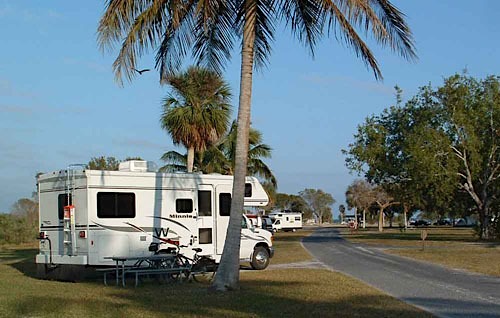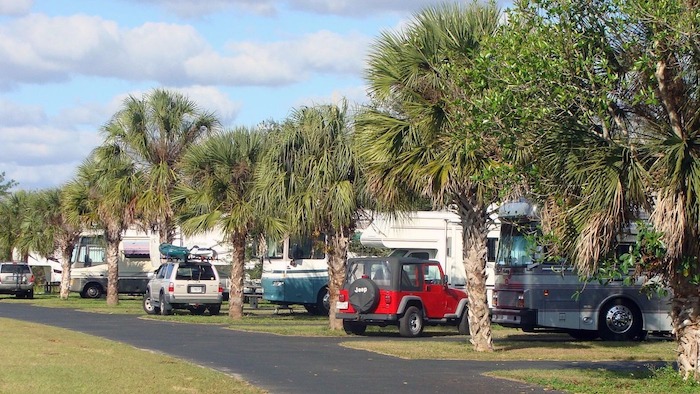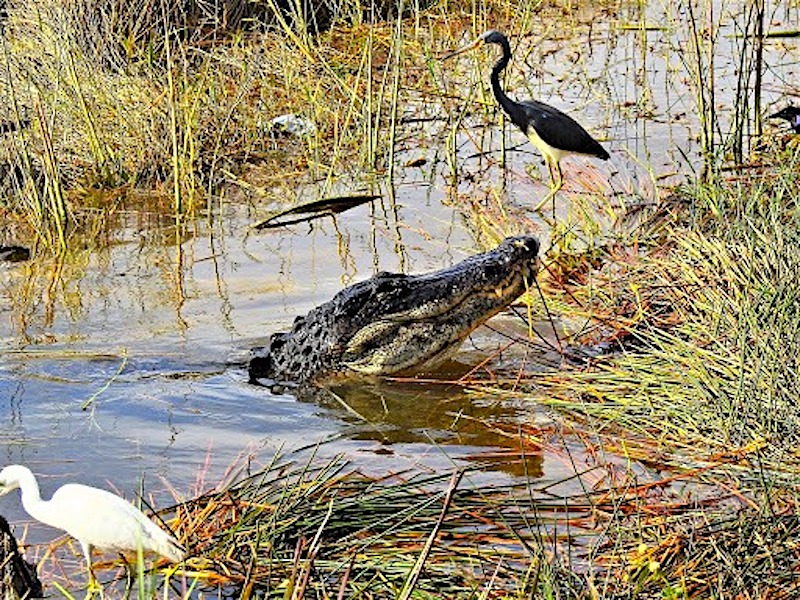Thanks for your support! If you make a purchase using our links in this article, we may make a commission. And, as an Amazon Associate, I earn from qualifying purchases. See the full disclosure here.
EVERGLADES NATIONAL PARK
Welcome to the “real” Florida. The Everglades was pegged “River of Grass” in 1947 by journalist and environmentalist, Marjory Stoneman Douglas. She brought to light the importance of preservation for this remarkable environment. Everglades National Park, founded in December 1947, now consists of 1.5 million acres. This vast region of tropical wetlands and sawgrass marsh is a unique ecosystem not found anywhere else on earth.
Everglades National Park Weather
You may think the Everglades is just one big swamp, but you’d be wrong. There are two seasons here, wet and dry. You’ve probably already guessed the best time to visit. Wet season runs May – October; while dry season finds you here November – April.
January – March are the busiest months, but you won’t find crowds as you do in many other national parks. With temperatures ranging from a high of 80 to lows in the mid-40s, this is the place to enjoy a Florida winter.
Another reason for visiting during the dry season are those annoying little things called mosquitoes. You won’t have many, if any at all, buzzing around while you’re RVing and enjoying outdoor activities during Florida’s winter months.
Hours of Operation and Entry Fees
Everglades NP is open 7/days/week, 24 hours/day. The park entrances are always open, but only staffed 8 am to 4:30 pm daily mid-November through April. During off-season, hours vary.
Entry fee for the park is $35/vehicle. The entry fee also helps support the park’s neighbor, Big Cypress National Preserve, which abuts the Everglades. The fee collected is good for a 7-day visit. If you possess an American the Beautiful or Federal Lands Pass, entry is free.
Visitor Centers in Everglades National Park
There are three entrances to Everglades NP but none of them are connected. They are accessed from different areas of South Florida. Due to the park’s immense size, there are four visitor centers covering various sections.
Located in Everglades City, the Gulf Coast Visitor Center serves as the gateway for exploring Ten Thousand Islands. Just east of Big Cypress National Preserve, Shark Valley Visitor Center sees many visitors each day. The Ernest F. Coe Visitor Center is accessed easiest by driving south from Miami or Homestead. Lastly, Flamingo Visitor Center, is remotely located by driving south 38 miles from the Ernest F. Coe Visitor Center.
All centers offer brochures, ranger-led activities, informative films or exhibits and are staffed to answer any questions.

Everglades National Park Webcam
A webcam was recently installed overlooking three points on the Anhinga Trail. You’ll spot various water birds, alligators, and even an occasional park ranger.
Campgrounds in Everglades National Park
Aside from backcountry campgrounds (permits required), there are two drive-in campgrounds located within the park that can accommodate RVs or tents. Flamingo Campground is near the Flamingo Visitor Center, and Long Pine Key Campground is closer to the Ernest Coe Visitor Center.
Flamingo Campground

Flamingo Campground, open year-round, has 120 drive-in campsites for RVs (up to 45’) or tents. Please note, only 41 sites (in Loop T) have electricity hookups. No other sites have amenities. There is a potable water station available for filling your RV fresh water tank or other containers. A dump station is also located on Loop T. Aside from the drive-in sites, there’s an additional 40 walk-in sites for tents.
The two camping loops (A and T) each have modern restrooms with showers. The restroom on Loop A houses the only solar-powered showers that provide warm to hot water, depending on the day and the usage. Whichever loop you’re camping on, feel free to use the restroom you prefer.
Each campsite has a picnic table and fire ring. A mile down the road, the Flamingo Marina sells ice, some camp supplies, convenience-type food and beer. For anything else, you’ll need to travel to Homestead, a 50-mile drive one-way.
Reservations are made through Flamingo Adventures (https://flamingoeverglades.com/), the park’s concessioner, or by calling 855-708-2207. Flamingo Adventures does not allow pass discounts. Campsites with electricity hookups are $42/night; sites with no amenities are $23/night. Campsites are assigned upon arrival depending on your needs when reserving. If requesting a particular site, make note of it while making a reservation and an effort will be made to accommodate.
There is no Wi-fi but those using AT&T should get cell service. Running a generator is acceptable with the exception being 8 pm to 8 am.
There are other cool options for lodging arrangements at Flamingo Campground. Houseboats rentals are available at $350/night, and travel within Whitewater Bay is allowed with that rental. Another option is their Floating Cottage Houseboats ($300/night) which remains docked during your stay.
If you don’t own a tent or RV, no worries! You can rent a Flamingo Eco-Tent (for two) for a true “glamping” experience. Eco-tents are set on a wood platform, contain one queen bed, are fully enclosed with canvas and screening and come with electric, bed linens, pillows, lighting, a fan, and a deck with seating for $50/night. There’s plenty of choices for Flamingo campers!

Long Pine Key Campground

Long Pine Key Campground is open November through April only. Located a few miles from Anhinga Trail, this campground offers 108 sites with approximately 25 set aside for tent campers. It can accommodate RVs up to 45’ and RV pads are paved.
There are no electric or water hookups at individual sites in this campground, however, each site has a picnic table and fire ring. Water refill stations are located throughout the campground, and restrooms include cold-water showers. A dump station is located at the exit of the campground. Generators can operate at RV sites from 8 am to 8 pm.
Reservations are also made via Flamingo Adventures. Again, campsites are provided upon your arrival, but efforts will be made to accommodate any requests. Cost for an RV site is $23/night. Tent sites are on a first come, first serve basis only.
There’s a 22-mile hiking trail accessible from Long Pine Key, and the campground’s lake will provide you some fun catch and release fishing. Obviously, swimming is not allowed. No one wants to get up close and personal with an Everglades alligator.

Boat Tours, Adventures and More!
Visiting the Everglades National Park in its entirety will require some time, but if you’re able to move from one section of the park to another, do it! It’s a birder’s sanctuary, a nature lover’s outdoor amphitheater and a fisherman’s paradise. One-third of the Everglades NP is covered by water. Wildlife abounds. Here’s some things to do depending on what areas of the park you’ll be visiting.
Gulf Coast Visitor Center, located in Everglades City on the Chokoloskee Bay, is considered the gateway to the 35,000-acre Ten Thousand Islands Wildlife Refuge. The 90-minute ranger-led boat excursion is offered daily from this location. Tickets can be purchased at the visitor center or online. It’s a wonderful introduction to these mangrove islands that are suspected to number beyond 10,000. You’re sure to see some playful dolphin along the way and white pelicans, migrating south for the winter, can be spotted. The Refuge serves to protect hundreds of wildlife species.
Ten Thousand Islands Wildlife Refuge
A dolphin pod in Ten Thousand Islands Wildlife Refuge
White Pelicans at Ten Thousand Islands Wildlife Refuge
Another journey by boat, the Mangrove Wilderness Tour, takes you deep into the swamp of the Everglades, just as many have pictured it to be. You’ll have the opportunity to ask questions and see wildlife such as alligators, fox squirrels, a variety of birds and perhaps even glimpse a native bobcat. Visit https://evergladesfloridaadventures.com/ for more information on these tours. This concessioner also rents canoes and kayaks to explore some cool spots on your own.
The national park now requires a Boater Education Program for operating private boats within its waters. The course is free and takes an hour to complete online. Due to the vastness of the Everglades, this course is given to protect important marine resources and provide safe and enjoyable visitor use. Please visit https://www.nps.gov/ever/planyourvisit/boater-education-program.htm.
Marsh Trail, located 17 miles from Everglades City, and west on Hwy. 41, is a 2.3-mile out and back trail within Ten Thousand Islands Wildlife Refuge. From the parking lot, the trail’s first ¼ mile is paved and brings you to a 2-story observation tower overlooking a portion of the Refuge. The remainder of the trail is crushed shell and provides views of the refuge marshes, water birds and even alligators.
Whether you’re a photography buff or not, Marsh Trail Observation Tower is known as a highlight for stunning sunsets. Plan to arrive 35 – 45 minutes before sundown. You’ll enjoy that time taking in the scenery and viewing a multitude of water birds. Ibis, tri-colored herons, little blue herons, wood storks, roseate spoonbills and egrets, to name a few, will be dotted across the landscape. It’s an inspiring sight to watch hundreds of birds fly home to roost on the mangrove islands as sun sets for the evening. Don’t forget to bring along water, insect repellent (if needed) and of course, binoculars.
Marsh Trail Observation Tower
Roseate Spoonbill at Marsh Trail
Birds Flying Home to Roost at Sunset
Several private airboat touring companies can be found in and near Everglades City that will propel you over the water and into the Everglades for an up close and personal tour. A quick google search will provide a listing of airboat operators in the area.
The Shark Valley Visitor Center location provides an excellent bicycling experience on its 15-mile paved loop trail. Taking this bicycle ecotour gives you the option to stop as often as you like as there’s many natural and wildlife viewing opportunities to take in through this section of the Glades. You’re welcome to bring your own bicycle or Shark Valley does have bikes for rent. Some may choose to walk a portion of the trail as well.
Wading Birds Along Shark Valley Loop Trail
Three Baby Alligators with Mama Close Behind at Shark Valley
Florida law requires anyone under 16 years of age to wear a bike helmet. Be sure to maintain a safe distance of at least 10’ from wildlife. Florida is the lightning capital of the United States so always check weather conditions before setting off by bike or on foot. Lastly, bring plenty of drinking water with you. The visitor center does sell bottled water and snacks.
If you’re not up for biking the loop, the park offers guided tram tours. This two-hour tour is narrated by a naturalist, not only providing you with an abundance of Everglades knowledge, but pointing out hidden aspects to make this a memorable trip. Five tram tours are provided daily and reservations are highly recommended (https://www.sharkvalleytramtours.com/). Peak season, November – April, finds Shark Valley a popular location.
Shark Valley Tram
Whether you explore by bike or tram, at the trail’s 7.5-mile mark sits a 45’ observation deck. Via a gradually sloped ramp, you’ll gain access to the deck for vistas of the surrounding Everglades you are traversing through. Close to the visitor center, there are also two short boardwalk trails.
Shark Valley Observation Deck
The Ernest F. Coe Visitor Center provides some exciting ranger-led programs. The Slough Slog Wet Walk (reservations required) has a ranger leading you 1 to 2 miles through the “river of grass” where you may observe a “gator hole,” wading birds, or see many a cypress knee. Long pants, socks, lace-up shoes and an adventurous spirit required.
A 45-minute guided starlight walk can be found on opportune evenings along Anhinga Trail as you listen for wild pigs, croaking frogs and find gator eyes staring in your direction.
Can You Spot Him?
The bike hike, another ranger-led event, explores up to 10 miles of unique Everglades wilderness.
On the road to Long Pine Key Campground, is a 14-mile round trip dirt bike trail. The trail ends for your return trek at Pine Glades Lake, the perfect spot to eat lunch, rehydrate and watch for wildlife.
The Anhinga Trail and Gumbo Limbo Trail are both 4 miles from the visitor center. Anhinga, a popular 1-mile trail, hosts an abundance of wildlife. It winds through sawgrass where you’ll catch sight of alligators, anhingas, herons, egrets and other native birds. The Gumbo Limbo is a 0.5-mile shaded hammock trail populated by Gumbo Limbo trees (yes, that really is a tree), Royal palms and plenty of air plants.
Everglades Flowering Bromeliad Airplant
Two others, Mahogany Hammock and Pahayokee Overlook are short trails within 20 miles of the visitor center.
Flamingo Visitor Center has loads to offer when you make your way to this part of the Everglades. This center is the farthest south in the park, but if coming from Miami, only an 80-mile drive.
From the visitor center, take the 90-minute boat tour through Buttonwood Canal into the mouth of Whitewater Bay. The Florida Bay tour, also 90-minutes by boat, outlines the unique flora and fauna of the Everglades and the history of Flamingo. Both tours have a naturalist on board and are scheduled for three departures daily. Visit www.flamingoeverglades.com for ticket info.
Canoe, kayak and bicycle rentals are also available at the website mentioned above. You can obtain awesome information at the visitor center or Flamingo Everglades for the best places to launch a canoe or kayak. With so much to see, paddling out on your own for a day or two, does a body good.
Kayakers for a Day on the Water
Hike or bike through Snake Bight Trail located 4 miles from the visitor center. No, in this case, Bight is not misspelled, so don’t let it fool you. Bight refers to a bay within a larger bay. In this case, Snake Bight (Bay) is within Florida Bay. This 1.6-mile one-way trail leads you to a boardwalk overlooking, none other than, Snake Bight.
Rowdy Bend Trail leads you through shady buttonwoods and open coastal prairie. It’s a good place to catch sight of woodland birds. Combine this trail with Snake Bight for a 12.6-mile bike ride from Flamingo Visitor Center.
Flamingo offers six other hiking trails between 0.5-miles and 2 miles in length. There is a 14-mile RT hike, Coastal Prairie Trail, which is accessed from the Flamingo Campground.
Several interesting ranger-led programs take place at this center. Learn about the American crocodile (Flamingo is the best place to spot them), the Florida manatee or the invasive Burmese python. The Everglades Adventure Car Caravan will have several cars following a ranger to various stops along the road to grasp more knowledge on the Everglades. Be prepared to drive your car approximately 40 miles.
Wildlife (and Your Pets)
First things first, can Fido come along on your adventure? Yes, dogs are allowed in front-country campgrounds and picnic areas within Everglades NP. You can also bring them with you to visitor centers, but they cannot come inside. Sorry, dogs are not allowed on any trails and it’s certainly not a good idea to have them anywhere near water in this park. While alligators look half-dead and lazy laying at the water’s edge, they can move mighty darn fast.
Now for the “wild” of your Everglades trip. We can’t possibly list the abundance of wildlife living in this oasis, but we’ll touch on a few that pique everyone’s interest.
From the remnants of the age of dinosaurs, the American alligator reigns in the Everglades and is considered a keystone species of the park. There are approximately 200,000 alligators living within the park’s boundary. The most important thing to remember is NEVER feed an alligator. The saying goes, “a fed gator is a dead gator.” Once they lose their fear of humans, that’s when the trouble begins. Many an alligator in lakes and rivers throughout Florida has been euthanized by trappers due to the gator being fed by humans. They do just fine on their own. As with any wildlife, please let them be wild.
American Alligator
The American crocodile, a unique species of the USA, is only found in South Florida. There are considerably less of them than their partner, the alligator, with an estimated 2,500 in the park. Recently downgraded from an endangered to a threatened species, crocodiles are known to be more aggressive but actually have a shy nature to them. Again, just keep your distance and respect their space. Both of you will be just fine.
Alligators and crocodiles play an important role in this ecosystem from keeping wildlife numbers in tact to creating mud holes that remain filled with water during dry seasons, thereby providing water for fish or other animals. The easiest way to tell the difference between the two, you might ask? Crocodiles have a narrow, more V-shaped jaw and snout while the alligator’s jaw and snout is wide, rounded, and U-shape.
Exhibit Noting the Difference in Alligator and Crocodile Jaws
The Everglades is a hot spot for birds. They are a huge part of this tropical environment. There are plenty of wading and predatory species calling the Everglades home. From ducks, wood storks, herons, egrets, pelicans, roseate spoonbills and onto eagles, osprey, hawks, owls, kingfishers and more, you won’t run out of bird watching opportunities.
Great Blue Heron
Wood Stork
Red Shouldered Hawk
Many mammals call this place home as well — deer, bats, manatees, dolphin, bobcats and pigs to name a few. One mammal you might not have thought of is the Florida black bear. With protection in place here and plant life galore, this is a utopia for black bears. They have adapted quite well to South Florida’s weather and conditions. Although they number less than 500 within the park, you may be in the right place at the right time to catch sight of one.
Another mammal most everyone would love to see is the regal Florida panther. This solitary creature is the most endangered cat in North America. The panther needs uplands for its habitat, but the Everglades is considered a wetland. Therefore, only a small number of the remaining 120 to 230 panthers in South Florida may find its way into the Everglades. Please see our article on Big Cypress National Preserve and the Florida Panther.
The plague most devastating to the Glades and its wildlife is one that has been going on for the past ten years – that of the Burmese python. Snakes from around the world have turned up in the Everglades but the most problematic by far is the python. Accidental and intentional release of any non-native species into a natural habitat is irresponsible. Many mammals have declined sharply due to the python which also threatens alligators, as their eggs are easy prey for them. The snake blends well into this landscape which has proven to be an environment where they can thrive.
The national park and its agents are working tirelessly to mitigate, manage and control the spread of pythons. It’s highly unlikely for visitors to come in contact with a python. Professional hunters are used and special designated permit-only hunt seasons are regularly scheduled for those wishing to help eliminate these snakes. Pythons can be killed on private property without a permit year-round. It’s not a story with necessarily a happy ending and will take years of research and mitigation efforts. Read more on efforts being taken to prevent the spread of the python in our Big Cypress National Preserve article.
Everglades National Park Maps
From marine navigation and channel markings to hiking and canoe trails, there are numerous maps to access outlining the Everglades. Be sure you’re armed with knowledge and the ability to find your way. (http://npmaps.com/everglades/)

Happy Trails
Everglades National Park is one-of-a-kind. It provides you an unmatched sense of adventure, distinctive landscape and a place to escape the crowds. It’s an unparalleled ecosystem and exceptional habitat for many rare and endangered species. You will find a wide range of activities and a lifetime of unforgettable memories.
There’s much still to be done to ensure the protection and restoration of the Everglades. Do yourself a favor by visiting this national park with all its wonder.




